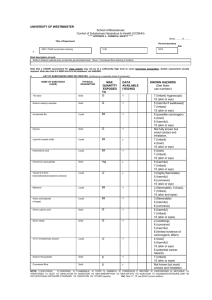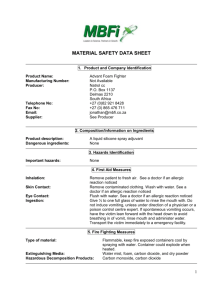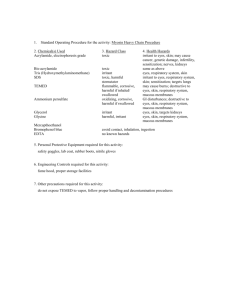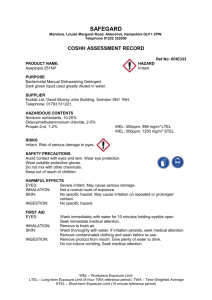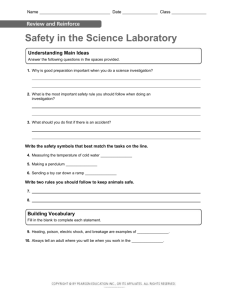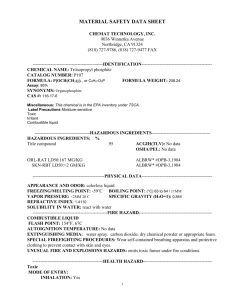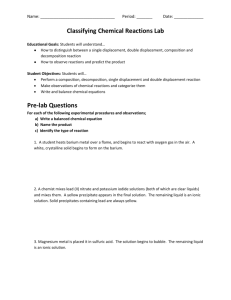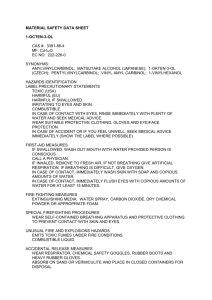ELISA and OPD
advertisement
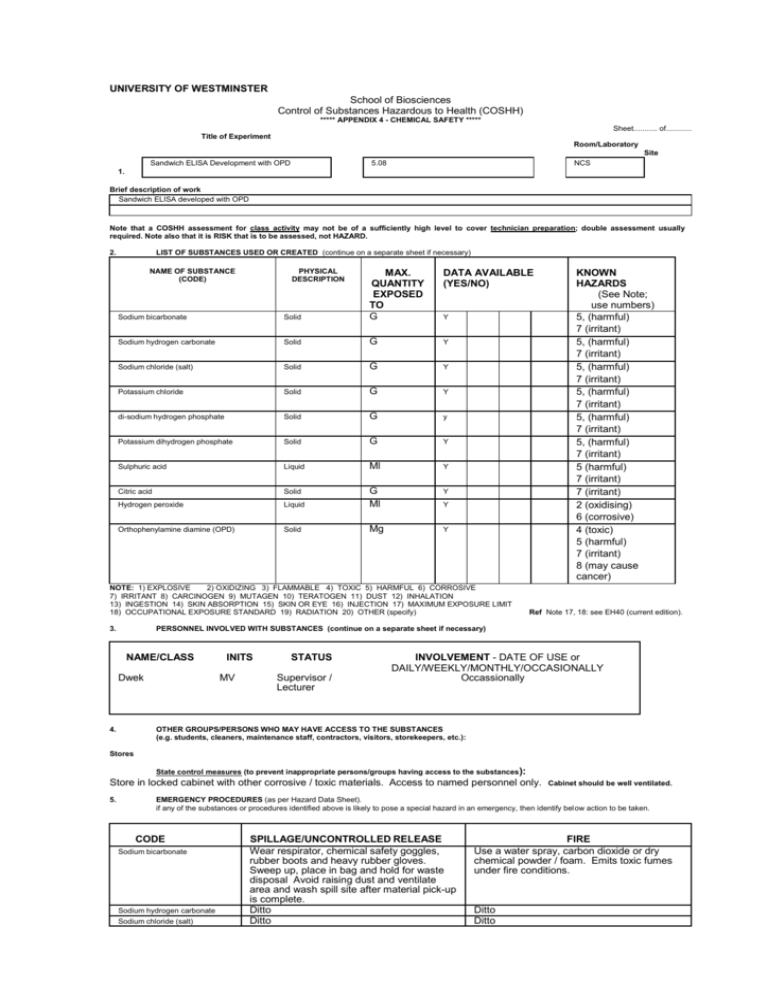
UNIVERSITY OF WESTMINSTER School of Biosciences Control of Substances Hazardous to Health (COSHH) ***** APPENDIX 4 - CHEMICAL SAFETY ***** Sheet........... of............ Title of Experiment Room/Laboratory Site Sandwich ELISA Development with OPD 5.08 NCS 1. Brief description of work Sandwich ELISA developed with OPD Note that a COSHH assessment for class activity may not be of a sufficiently high level to cover technician preparation; double assessment usually required. Note also that it is RISK that is to be assessed, not HAZARD. 2. LIST OF SUBSTANCES USED OR CREATED (continue on a separate sheet if necessary) NAME OF SUBSTANCE (CODE) PHYSICAL DESCRIPTION Sodium bicarbonate Solid MAX. QUANTITY EXPOSED TO G DATA AVAILABLE (YES/NO) Sodium hydrogen carbonate Solid G Y Sodium chloride (salt) Solid G Y Potassium chloride Solid G Y di-sodium hydrogen phosphate Solid G y Potassium dihydrogen phosphate Solid G Y Sulphuric acid Liquid Ml Y Citric acid Solid Liquid G Ml Y Hydrogen peroxide Orthophenylamine diamine (OPD) Solid Mg Y Y Y NOTE: 1) EXPLOSIVE 2) OXIDIZING 3) FLAMMABLE 4) TOXIC 5) HARMFUL 6) CORROSIVE 7) IRRITANT 8) CARCINOGEN 9) MUTAGEN 10) TERATOGEN 11) DUST 12) INHALATION 13) INGESTION 14) SKIN ABSORPTION 15) SKIN OR EYE 16) INJECTION 17) MAXIMUM EXPOSURE LIMIT 18) OCCUPATIONAL EXPOSURE STANDARD 19) RADIATION 20) OTHER (specify) 3. KNOWN HAZARDS (See Note; use numbers) 5, (harmful) 7 (irritant) 5, (harmful) 7 (irritant) 5, (harmful) 7 (irritant) 5, (harmful) 7 (irritant) 5, (harmful) 7 (irritant) 5, (harmful) 7 (irritant) 5 (harmful) 7 (irritant) 7 (irritant) 2 (oxidising) 6 (corrosive) 4 (toxic) 5 (harmful) 7 (irritant) 8 (may cause cancer) Ref Note 17, 18: see EH40 (current edition). PERSONNEL INVOLVED WITH SUBSTANCES (continue on a separate sheet if necessary) NAME/CLASS Dwek 4. INITS MV STATUS Supervisor / Lecturer INVOLVEMENT - DATE OF USE or DAILY/WEEKLY/MONTHLY/OCCASIONALLY Occassionally OTHER GROUPS/PERSONS WHO MAY HAVE ACCESS TO THE SUBSTANCES (e.g. students, cleaners, maintenance staff, contractors, visitors, storekeepers, etc.): Stores State control measures (to prevent inappropriate persons/groups having access to the substances ): Store in locked cabinet with other corrosive / toxic materials. Access to named personnel only. 5. Cabinet should be well ventilated. EMERGENCY PROCEDURES (as per Hazard Data Sheet). if any of the substances or procedures identified above is likely to pose a special hazard in an emergency, then identify below action to be taken. CODE Sodium bicarbonate Sodium hydrogen carbonate Sodium chloride (salt) SPILLAGE/UNCONTROLLED RELEASE Wear respirator, chemical safety goggles, rubber boots and heavy rubber gloves. Sweep up, place in bag and hold for waste disposal Avoid raising dust and ventilate area and wash spill site after material pick-up is complete. Ditto Ditto FIRE Use a water spray, carbon dioxide or dry chemical powder / foam. Emits toxic fumes under fire conditions. Ditto Ditto Potassium chloride di-sodium hydrogen phosphate Potassium dihydrogen phosphate Sulphuric acid Citric acid Hydrogen peroxide Orthophenylamine diamine (OPD) Ditto Ditto Ditto Ditto Ditto Ditto Wear respirator, chemical safety goggles, rubber boots and heavy rubber gloves. Absorb on sand and place in closed containers for disposal. Ventilate area and wash spill site after material pick-up is complete. Wear respirator, chemical safety goggles, rubber boots and heavy rubber gloves. Sweep up, place in bag and hold for waste disposal Avoid raising dust and ventilate area and wash spill site after material pick-up is complete. Wear respirator, chemical safety goggles, rubber boots and heavy rubber gloves. Absorb on sand and place in closed containers for disposal. Ventilate area and wash spill site after material pick-up is complete. Wear respirator, chemical safety goggles, rubber boots and heavy rubber gloves. Sweep up, place in bag and hold for waste disposal Avoid raising dust and ventilate area and wash spill site after material pick-up is complete. Ditto Ditto Ditto Dissolve or mix with a combustible solvent and burn in a chemical incinerator equipped with an afterburner and scrubber. If personnel are affected (fumes, contamination, etc.) treatment to be adopted: SPECIFY PER SUBSTANCE (CODE AS PER HAZARD DATA SHEET) sodium bicarbonate, sodium hydrogen carbonate, sodium chloride, potassium chloride, di sodium hydrogen phosphate, potassium dihydrogen phosphate If swallowed, wash out mouth with water provided if person is conscious. Call a physician. If inhaled remove to fresh air. If breathing becomes difficult call a physican. In case of contact immediately wash skin with soap and copious quantities of water. In case of contact with eyes, flush with copious quantities of water for at least 15 minutes. Assure adequate flushing by separating eyelids with fingers. Call a physician. Sulphuric acid, citric acid, hydrogen peroxide If swallowed, wash out mouth with water provided if person is conscious. Call a physician. If inhaled remove to fresh air. If breathing becomes difficult call a physican. In case of contact immediately wash skin with soap and copious quantities of water. In case of contact with eyes, flush with copious quantities of water for at least 15 minutes. Assure adequate flushing by separating eyelids with fingers. Call a physician. Orthophenylamine diamine In case of an accident or if you feel unwell, seek medical advice immediately. In case of contact with eyes rinse immediately with plenty of water and seek medical advice. (NB. Antidotes and special treatment may be obtained through...................................................................................................................................) 6. CONTROL MEASURES TO BE ADOPTED (NB. Consider the following points, the appropriate Biosciences Safety Code plus any other necessary measures. SPECIFY PER SUBSTANCE AS NECESSARY FOR EACH OF THE ITEMS BELOW.) Always use TFA in fume cupboard, wear gloves (see COSHH form attached). Always add acid to water in small volumes NOT water to acid. 1. Limiting exposure time of personnel - state maximum time 2. Partial enclosure with local exhaust ventilation 3. Local exhaust ventilation 4. Sufficient general ventilation 5. Personal protective equipment (goggles/gloves/clothing/mask/breathing apparatus/safety screen, etc.) SPECIFY * 6. Safe disposal/storage of hazardous substances * 7. Regular cleaning of the workplace * 8. Adequate washing facilities * = MANDATORY STORAGE - SAFETY CONSIDERATIONS Sulphuric acid – toxic store cabinet Citric acid – shelf of lab. Hydrogen peroxide - fridge HANDLING PRECAUTIONS Always wear gloves and goggles. Use in fume hood. Orthophenylamine diamine - fridge Wear gloves and avoid breathing dust Sodium and potassium salts – lab shelf Wear gloves and avoid breathing dust DISPOSAL PROCEDURES DURING AND AT END OF EXPERIMENT Dispose of plasticware after autoclaving via laboratory waste route. Dispose acid solutions via chemical disposal officer. 7. REVIEW AND MONITORING OF CONTROL MEASURES (Required checks, and their frequency, on the adequacy and maintenance of the control measures during the course of the experiment) (NB. Biosciences Safety Code in respect of health surveillance needs. This form is not adequate if health surveillance is required.) 8. OTHER RELEVANT INFORMATION (continue on a separate sheet if necessary) (e.g. restriction of usage; transportation risks; labelling requirements; assessment review date, etc.) 9. I certify that, to the best of my knowledge, the above precautions will adequately control the risks from the hazardous substances listed. I have brought the assessment to the notice of the relevant technicians; academic staff; students; researchers (delete as necessary). Name of Assessor: Miriam Dwek Signed: Status of Assessor: Lecturer Date:
